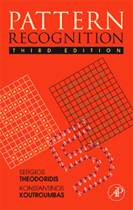|
The release of the third edition of Pattern Recognition by Theodoridis and Koutroumbas warrants a review of this general text covering our field. The book is aimed at the university course market and it achieves that goal well. This is an excellent choice to accompany an advanced undergraduate or graduate school course. The book is extensive enough to offer the option of teaching from it for one- or two-semesters. To supplement the coursework, there are many problems at the end of each chapter. In addition, each chapter�s reference section provides a one-stop resource for students to choose papers for advanced work or projects. The book is written in a very readable, no-nonsense style. I found that there was just the right amount of text to describe a concept, without extraneous verbiage. The same is true for the mathematics, enough for description, not too much to overwhelm. Explanatory text always accompanies the math, allowing the reader to understand first by text before delving into the equations or vice versa, depending upon their preference. Like the text and equations, figures contain no extra details other than those needed to illustrate the pertinent topics. These are usually point plots, line drawings, and graphs that complement the textual descriptions. Most, although not all, of the topics have accompanying figures. Although there are some example problems worked out in the body of many of the sections, the number of these is relatively few, certainly many fewer than the 20-30 problems at the ends of the chapters. This is one reason that the text is not aimed at levels lower than advanced undergraduates. The book is also not aimed at practitioners who are looking for a quick �cookbook� text to implement algorithms in their fields (e.g., speech, image, motion, etc.) quickly. It would be better for these practitioners to buy a book devoted to that topic. However, if the practitioner wants to understand the basics of pattern recognition, this book is well-suited. The content follows a traditional sequence for teaching a pattern recognition course. The topics of the first chapters are: Bayes classifiers, linear classifiers, non-linear classifiers, and feature selection. Then the book turns to global transforms, including Fourier, Karhunen-Loeve, and wavelet. Less general, more application-dependent features are then discussed, including chain codes and fractals for image processing, and the cepstrum for speech processing. Following this is a chapter on template matching. This might end a one-semester (or quarter) course on pattern recognition, perhaps with a little extra material from the following chapters. The remaining chapters in the book, Chapters 11-16, all deal with aspects of clustering. These chapters begin with basic clustering concepts. Following this, sequential and hierarchical algorithms for clustering are treated in separate chapters. Clustering algorithms are described that are based on functional optimization, including the Isodata and k-methoids algorithms. More clustering algorithms are described that use learning, graph theory, and binary morphology. The last chapter delves into methods for testing cluster validity. I tried to see if any popular topics � now or at some time in the past � were missing in the book, but coverage appears to be comprehensive. As a sampling, all the following topics were included: neural networks, fuzzy clustering, wavelets, morphology, simulated annealing, and hidden Markov models (HMMs). Although many references accompanied each chapter, one suggestion for the next edition of the book is to update this to include more recent references. Most references are from the 1970�s, 80�s, and 90�s (decades of great productivity in the pattern recognition field). However, there are more papers in the late 1990s and post-2000 that might also be included � especially if one purpose for inclusion of these references is for students to choose project work. In summary, I very much enjoyed reading through this book. I believe it would be an excellent choice for coursework, meeting the satisfaction of both professor and students.� Obviously, as this is the 3rd edition, it has been used in this way for many classes and good professors will continue to choose it. |

|
BOOKSBOOKSBOOKS
Pattern Recognition, 3rd Edition
By Sergios Theodoridis, Konstantinos Koutroumbas Academic Press, 2006
Reviewed by:� Larry O�Gorman |
|
Book Reviews Published in the IAPR Newsletter
Dictionary of Computer Vision and Image Processing R.B. Fisher, et. al., Jan. �06
Kernel Methods for Pattern Analysis by Shawe-Taylor and Cristianini, Oct. �05
Machine Vision Books, Jul. �05
CVonline:� an overview, Apr. �05
The Guide to Biometrics by Bolle, et al Jan. �05
Pattern Recognition Books, Jul. �04 ������������ ������������ [pdf] |



|
Click above to go to the Academic Press web page for this book where you can view the Frontmatter, including the Table of Contents, and Chapter 1. |
